Menus
- Evolution or revolution of the ER6-f with the in-line twin of 649 cm3, 68 horsepower for 193 kilos
- A more sporty look but, paradoxically, a gain in comfort, ease and efficiency
- Discovery
- In the saddle
- In the city
- On motorways and main roads
- On departmental
- Part-cycle
- Brakes
- Comfort and duo
- Consumption / autonomy
- Conclusion
Evolution or revolution of the ER6-f with the in-line twin of 649 cm3, 68 horsepower for 193 kilos
A more sporty look but, paradoxically, a gain in comfort, ease and efficiency
Change of course for Kawasaki: on the basis of the Er-6, which appeared in 2005 in roadster versions (Er-6n) and then more road (Er-6f), the Akashi brand returns to historic names. The roadster becomes Z and the road adopts a sportier attitude and, suddenly, deserves its “Ninja” logo. In both cases, the in-line twin complies with the Euro 4 standard by becoming more flexible and more torquey, while the great technical novelty comes mainly from the chassis, completely revised and which saves the modest mass of 19 kilos on the roadster. and 18 on the road !
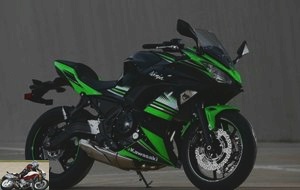
It will not have escaped anyone’s notice that, in doing so, the Ninja was clearly more seductive than her predecessor. Which can only do good for the business model of the machine, which sold just 10 times less than its naked sister. Other countries, on the other hand, were almost in the opposite proportions: United States, Germany, Great Britain.
In fact, the Ninja 650 is intended to be a career that is both brilliant and global: large cube in emerging countries (Latin America, Southeast Asia), access motorcycle or more reasonable machine for a fairly large target in the West. , the little Kawa relies on its looks to convince, but also on a new sum of qualities among which the ease of driving and the overall homogeneity figure at the head of the gondola. Does she have the means for her ambitions ?
Discovery
In its green and black "Kawasaki Racing Team" colorway, there is no doubt that the family link with the more exclusive machines in the range is obvious. The fairing is more sporty, the tapered front is openly inspired by the ZX-10R, with a small plastic protuberance that runs in front of the optics. The rear section now features a double-stage saddle surrounded by a more tapered shell, while the LED tail light shows an "X" shape. Other colors are (a little) more discreet, such as metallic orange, or much more, in the case of black.
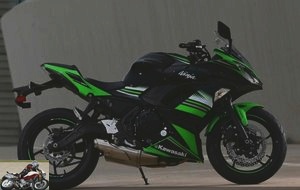
It is therefore difficult to recognize the basis of the previous Er-6, especially as the trellis frame, swingarm, exhaust, wheels and brakes are new. Enough to allow yourself to fully talk about the new model.
By approaching a little, we discover a machine, certainly stylish, but whose ergonomics do not seem radical. The dashboard is complete, the screen is adjustable, the levers too. The Ninja looks mean but seems to be able to take care of her crew !

In the saddle
Good news: the saddle is now 790mm high, compared to 805 on the previous ER-6f. The tank is narrow and the half-handlebars offer a slightly sportier position than on the road before, but without any excess. The two levers are easily adjusted using knobs offering 5 positions. The tank is narrow. Everything has been done, like the Kawasaki target, to make this Ninja as accessible as possible. The first sport-oriented motorcycle of a biker career? Or even the one with which we can really start? Yes, there is that. The other good news is that even large stakes like me (1.88 m) finally feel quite comfortable on the handlebars, with legs that are not too bent and that fit well in the notches of the fairing..
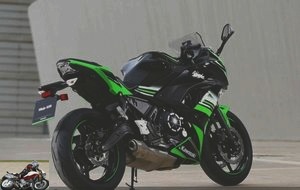
All that remains is to switch on the ignition. The dashboard, as has been said, is complete. It has essential information, such as the time, average consumption, autonomy and an "eco" indicator that is a bit of a gadget, but Kawasaki seems to stick to it for a few years. The tachometer takes the central position and the shiftlight is adjustable over a range of 5 to 11,000 rpm, in increments of 250 rpm. The intensity of the light alert also. The commodos, on the other hand, are those of the old generation, but they still include a command for warnings.
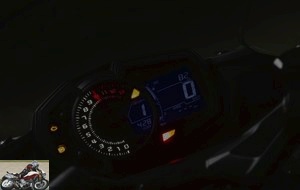
If, by ear, we can still detect the typical "staccato" of in-line twin cylinders set at 180 °, the sound of the new exhaust is however more harmonious, with a more marked hum … This contributes to the pleasure of driving with this little Ninja.
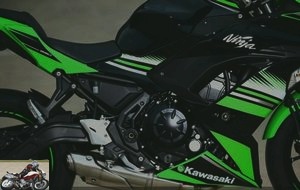
In the city
We remembered the older generations of Er-6 as engines that were not very smooth and thumped at low revs (this was a little less true with the Versys 650, with the engine a little deflated). Well, let us praise the virtues of Euro 4, because the parallel twin of 649 cm3 has clearly gained in flexibility. We can indeed drive at 3000 rpm in 4th without any jolts (or even at 2100 rpm in sixth, even if we are there at the limit of flexibility of the block.
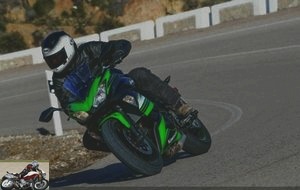
In urban developments, we also welcome the softness of the clutch, the gearbox that is generally forgotten, with a neutral point super easy to find. Total ease, again, even if sometimes, a very slight blow to the throttle is felt on changes at very low speed.
For the rest, the turning radius is good and the slimming cure is beneficial: the Ninja 650 is certainly the most obvious sporty looking machine to take to town..
On motorways and main roads
As we can imagine, the bubble does not protect much in the low position. On the national road, the twin purrs at 4,100 rpm in 6th gear at 90 km / h, at 5,100 to 110 km / h and at 6,100 to 130 km / h. At legal speed, we are then at 4000 rpm from the red zone: enough to see coming! No parasitic vibration is to report, nor resonance in the casing, as could sometimes be the case on the Er-6f. As indicated in our previous technical article on the Ninja 650, the engine certainly lost some horsepower in the operation (68 now instead of 72), but it gained in roundness and especially in torque in the usual modes. Suddenly, the resumes in sixth are not stratospheric, of course, but they are still consistent and it is not necessarily necessary to downshift to overtake..
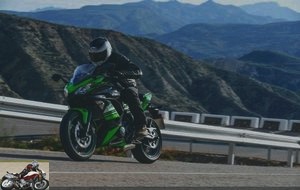
After the lunch break, the bubble was placed in the high position and we thus gain 60 mm of protection. The helmet is always at the mercy of the wind, but the shoulders of a tall (by size) pilot will be protected. Bodes well for smaller riders.
By pure professional conscience, on a German section of our route, we took 200 km / h at 9,500 rpm in sixth, but it was only because there were other journalists in front of me who were doing the same and that I did not want to lose the way to the hotel. The bike gets on easily without ever running out of steam and stability, even in large curves, is no problem..
On departmental
Here is an ideal playground for this medium displacement. We have swallowed, sometimes at a good pace, several hundred turns and the first observation is that this machine is healthy, playful, fun and accepts the ride just as much in very correct conditions as it does to be pushed around a bit. . Among the good news: precise front axle, sufficiently powerful and perfectly dosable braking, not too intrusive ABS, ease of movement on the handlebars.
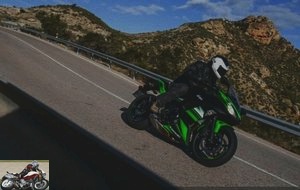
Another good surprise: the suspensions. Admittedly, they are not literally exceptional, but anyway this is never the case on entry-level machines or of this price point. And yes, the rear is sometimes a little too dry, both in compression and in relaxation, on small irregularities. But despite everything, if the machine moves a little on the compressions on the attack, there is never anything unhealthy. And in their reactions, we never note a violent hit with the racket or vertebrae.
What is more average are the tires: the Dunlop D214 take a long time to heat up (especially the front, the rear, that’s fine) and at the start of driving, on somewhat dusty asphalt and sometimes average grip. , we had a few glides from the front. Their feedback is not extraordinary either even if, by rewinding, it is possible to keep a relatively high pace..
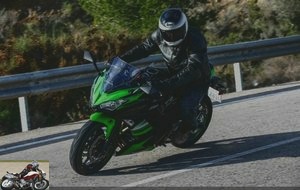
As for the engine, it seduces by its ease, its roundness and its permanent availability. Full from 4-5000 rpm, it then pushes with linearity and even gains a small surplus of force between 8 and 9500 rpm, regime to which it gave everything. No need, therefore, to go and tease the breaker. Finally, the gearbox is forgotten (not even a false neutral during the test and it accepts both energetic downshifts and upshifts on the fly without using the clutch).
Part-cycle
18 kilos less, that counts! And the trellis frame as well as the new pressed steel swingarm are marvelous, especially since they are assisted by a new rear shock absorber in a central position which optimizes the centralization of the masses. As a result, the Ninja 650 is a fun and perfectly healthy mid-size. The caster angle has gained one degree, going from 25 ° to 24 °. We can’t already say that the Er-6f was an anvil: the Ninja 650 is a bike.
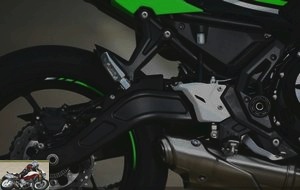
Brakes
The Nissin 2-piston calipers pinch 300mm discs up front and are backed up by a Bosch 9.1 ABS power unit which does the job well, since even on rough roads, ABS triggers are rare. The braking is adjustable, which will reassure beginners, but it then offers a good attack, as well as a level of power which is very satisfactory and in any case perfectly in line with the weight and the performance of the machine..
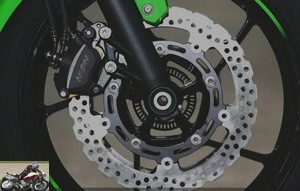
Comfort and duo
Let’s start with a bad point: those who appreciated the Er-6f for its versatility and ability to ride in duos will see the Ninja 650 as a regression. Because the passenger (or the passenger as well as, in accordance with the ecumenical mission of the Den, all our LBGT friends), are now high on a double-decker saddle and without a grab handle. Hard. For the pilot, on the other hand, things are going well! The comfort is amazing, with correct suspensions, as we have said, but also a saddle that does not tire the foundation even after several hours of driving. Little protection, of course, but no vibrations. But good !
Consumption / autonomy
With the new settings of its engine, Kawasaki announces a consumption having increased by 6.8% and an average of 4.3 l / 100. It is quite possible, because from experience, we know that the previous Er-6 knew how to be sober. On the on-board computer, we noted an average consumption of 5.1 at a cautious but reasonably cheerful pace and in the afternoon, 5.4 by already tapping more into it, with climbs all in 2 and in 3 to 9000 rpm. In short, the announced sobriety seems to be there, but it was not a surprise! In fact, with the 15 liters of the tank, a range of 250 to 300 kilometers is quite possible..
Conclusion
Kawasaki has managed to reconcile extremes with this Ninja 650, a very serious evolution of the Er-6f. On the one hand, a more sporty look that will undoubtedly appeal to the many fans of the green brand and the Ninja spirit. On the other and we must salute the performance: making an efficient motorcycle and above all easy to access and grip, perfectly healthy in its behavior and very homogeneous..
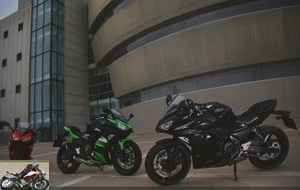
A machine that can be entrusted to beginners who will appreciate its contained weight, the roundness and availability of its engine, its smooth and well calibrated controls. As for more experienced bikers, they will appreciate the completely correct performance and the "cycling" side of this healthy machine which knows how to give a lot of pleasure. With that, the Ninja has everything to increase the ratio of 1/10 against the Z650 !
Strong points
- Ease of handling
- Smoother and more torquey engine
- Look more djeunz ‘
- Healthy and efficient chassis
- Complete dashboard
- Price / performance ratio
Weak points
- Versatility in slight decline (duo)
- Tire assembly not in line with the sporty look
Kawasaki Ninja 650 technical sheet
Test conditions
- Itinerary: 260 kilometers in the Almeria region, in southern Spain, with a majority of winding mountain roads and some connections in the valley bottoms…
- Motorcycle mileage: 300 km
- Problem encountered: none
Competition: Honda CBR 650 F
Related articles
-
Roadster with Sugomi sauce or decarenated sports car A2 licenses have the choice between large bridles, sometimes very badly bridled, and smaller ones,…
-
40 horses at 11,500 rpm 25.7 Nm, 175 kilos with full tank, two colors, € 5,799 An easy and sparkling little trail: what if life on a motorcycle was as…
-
Kawasaki Z 750 R motorcycle test
The Z super Roadster version ! There are emblematic models by their distribution, the commercial enthusiasm they arouse. The Z 750 is in this vein. With…
-
A new little sports car accessible to A2 licenses Twin cylinder in-line, 399 cm3, 45 hp at 10,000 rpm, 38 Nm at 8,000 rpm, 168 kilos, from € 5,999…
-
Rock’n roll attitude ! Sitting less than 70 cm from the ground, feet propped far forward and holding the wide handlebars of the VN 900, I taste the…
-
Sporty for big cube bikers The Kawasaki 300 Ninja succeeded the 250 Ninja in 2013. While the 250 was a nice little bike, the 300 underwent a bodybuilding…
-
2012 Kawasaki ER-6f motorcycle test
Swiss army knife first price While the ER-6n has been a historic bestseller in the Kawasaki lineup since its debut in 2006, its streamlined “f” version…
-
Ninja Apprentice On paper, we imagine that the Kawasaki Ninja 250 R, with only 33 horsepower, will only appeal to the young drivers. After a week of…
-
4 cylinders in line, 948 cm3, 111 hp at 8,500 rpm, 10 m / kg at 6,500 rpm, 215 kilos, from € 11,999 A skillfully modified Z 900 or the worthy heir to the…
-
The first big bike intended for beginners, 806 cm3, 95 hp adjustable at 47.5 hp Simple recipes for a beautiful rewarding machine In its great kindness,…
A big fat disgusting fleet radia up front, zero effort to integrate and / or hide it, and a ridiculously small front fender, on purpose to throw all the gravel right into the radia..
Just: well done
The Ninja being rather comfortable in the genre, it is done without too much hassle
Philippe
Yes, it is true that this big hose…
Worse the mechanism of the front axle in black, it’s a shame. Something like that has to show.
1000 € difference on new purchase, and how much on resale in 1 or 2 years ???
2000, 3000 ?
Already a Japanese motorcycle is discounted quickly but a Chinese …
In the future if the price is contained, it will become a formidable competitor.
France is still reluctant but like Benelli in Italy or Spain, these new brands will score points among young bikers with limited budgets. An unknown, the resale rating.